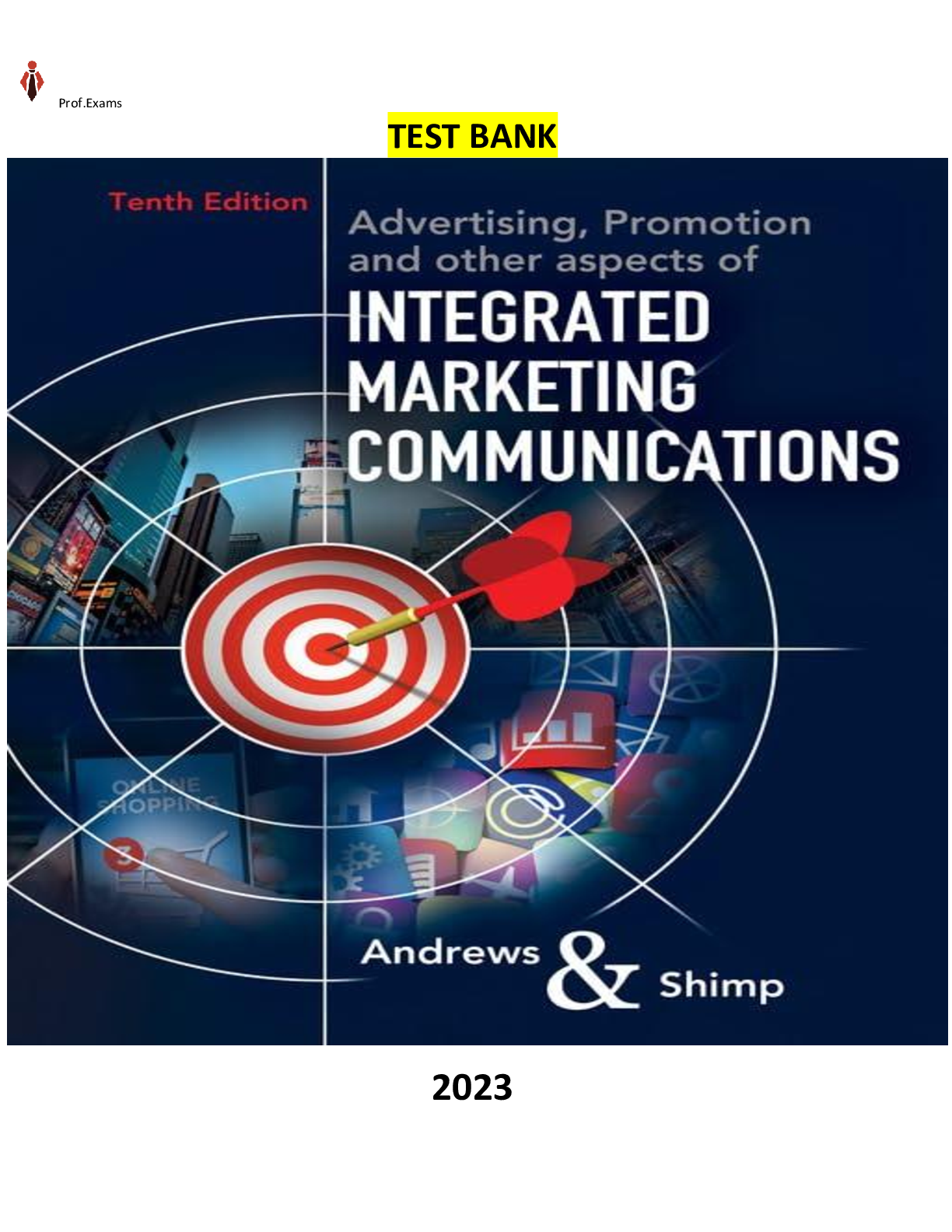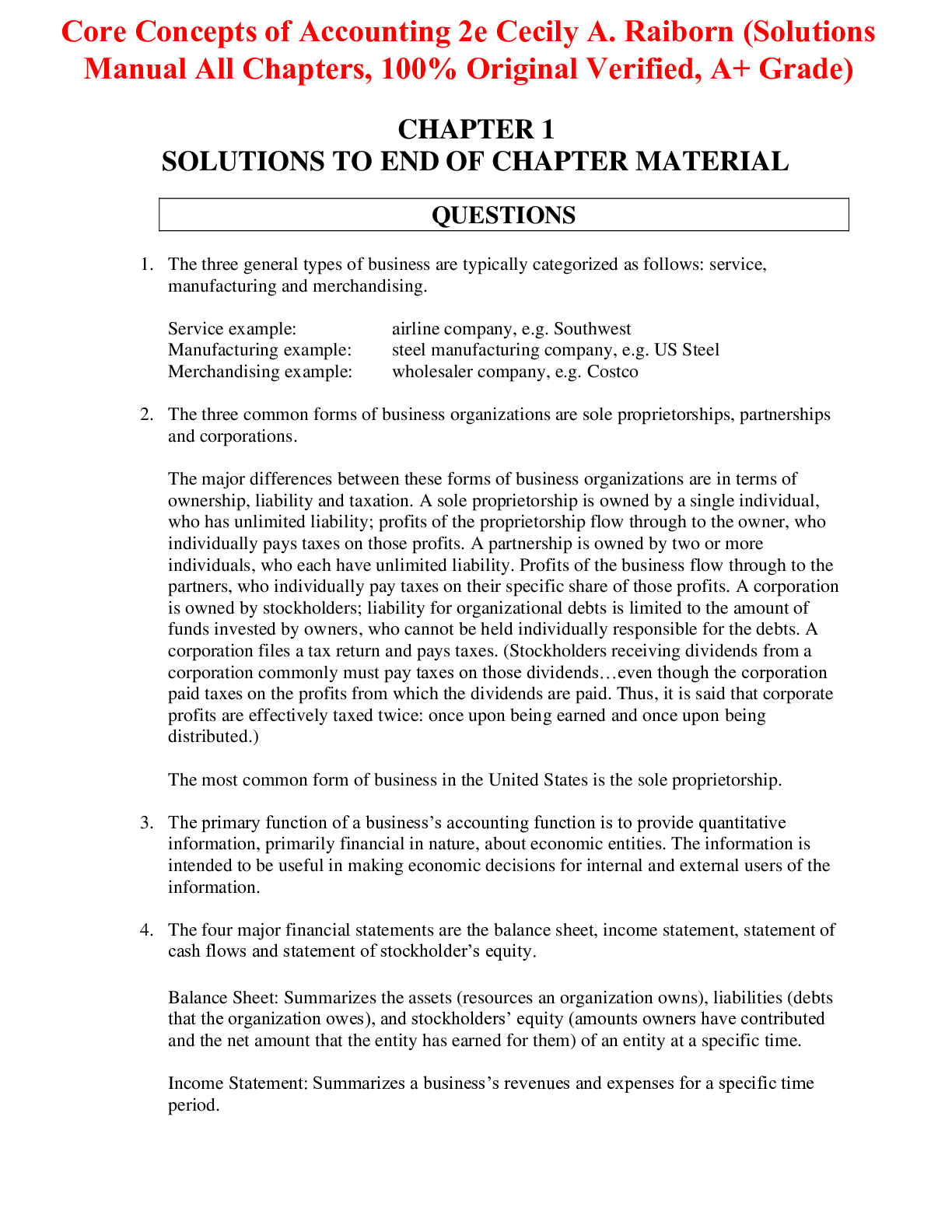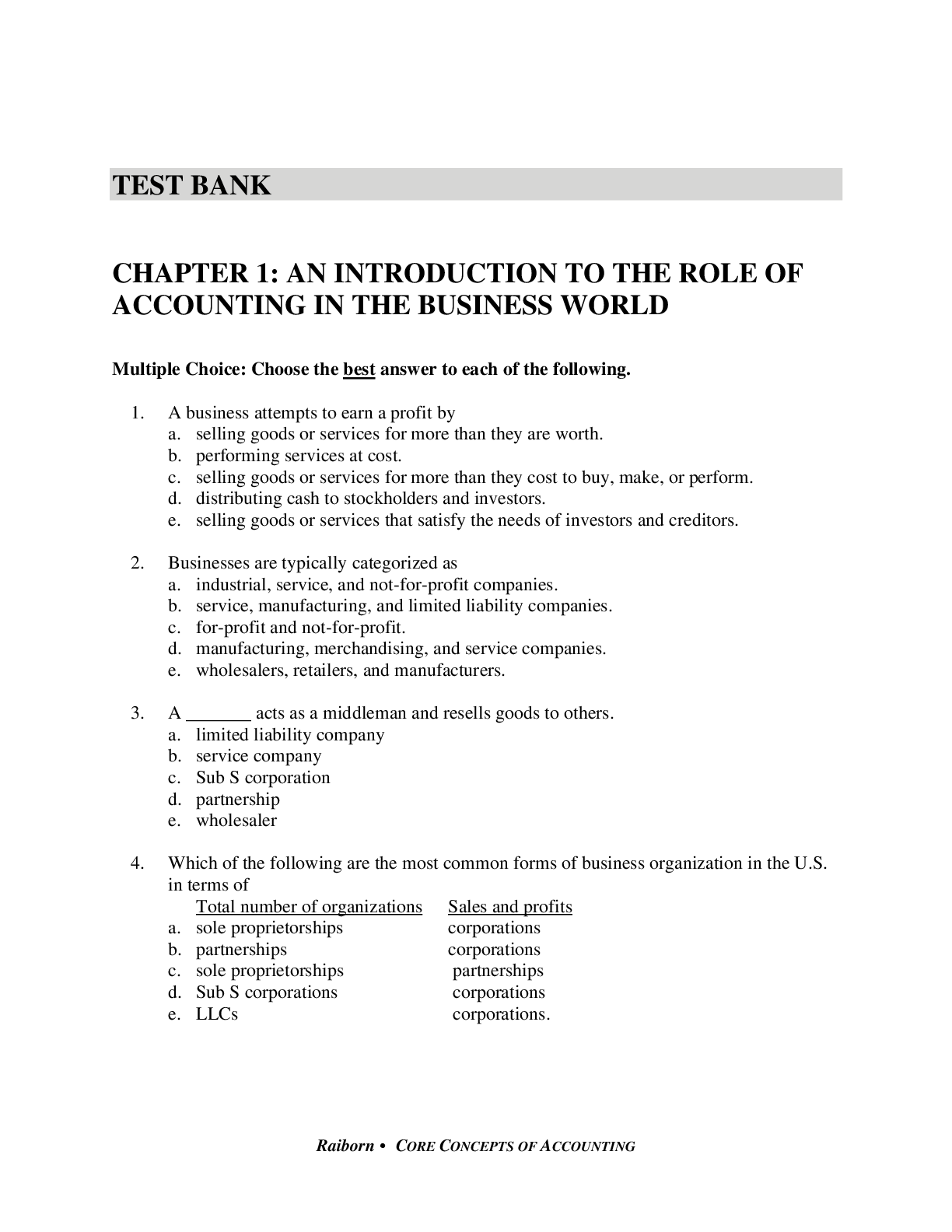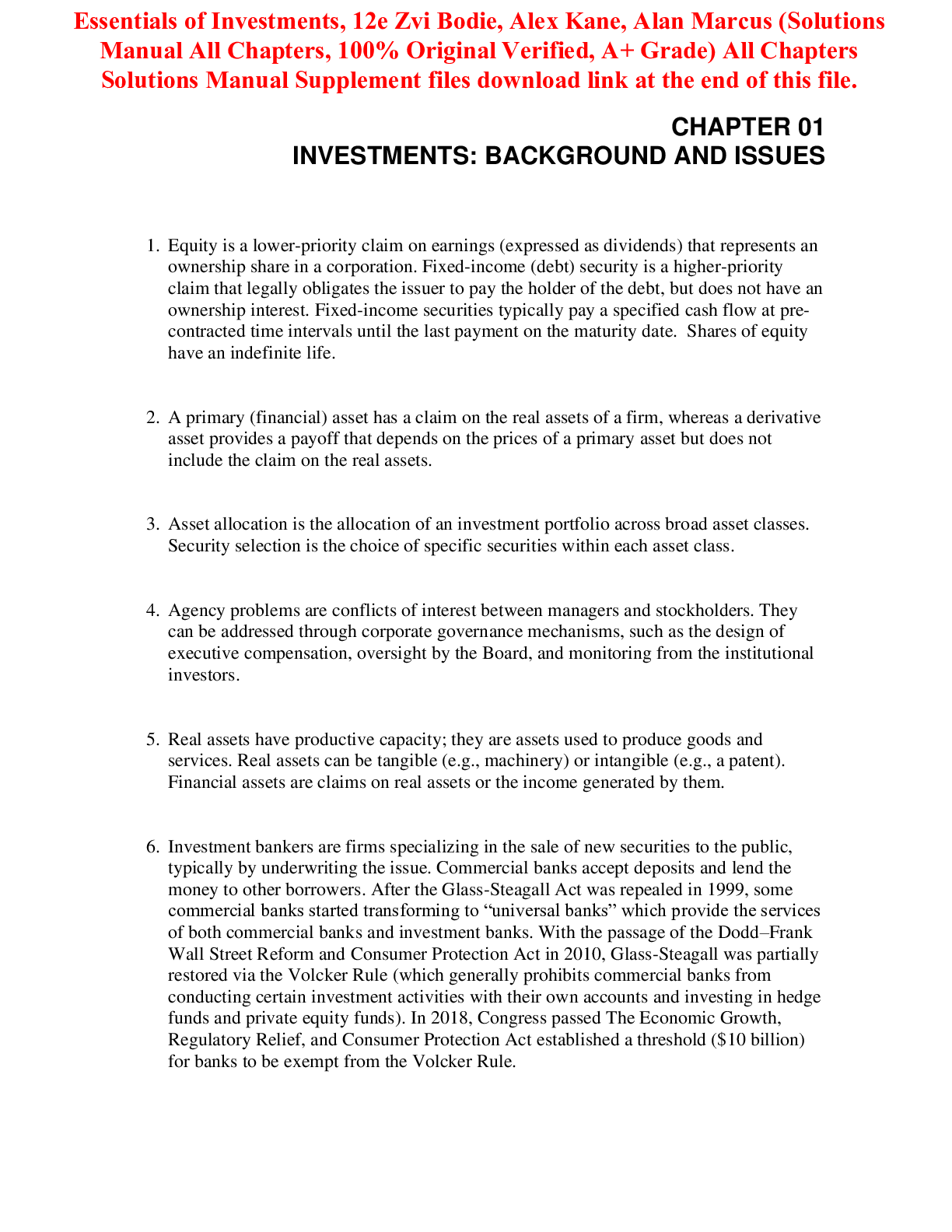Information Technology > SOLUTIONS MANUAL > Solutions Manual Information Systems A Manager’s Guide to Harnessing Technology Version 8.0 by Gal (All)
Solutions Manual Information Systems A Manager’s Guide to Harnessing Technology Version 8.0 by Gallaugher
Document Content and Description Below
Chapter 2 Strategy and Technology: Concepts and Frameworks for Achieving Success Chapter Introduction This chapter describes competitive advantage and explains how IT acts as an enabler of comp... etitive advantage. It describes the limitations of technology-based competition and emphasizes the need for sustainable competitive advantage. The chapter discusses the value chain and the role of brand, scale, data and switching cost assets, differentiation, network effects, and distribution channels. It attempts to describe the relationship between timing, technology, and the creation of resources for competitive advantage. The chapter also covers the five forces of competitive advantage. 1. Introduction • Define operational effectiveness and understand the limitations of technology-based competition leveraging this principle. • Define strategic positioning and the importance of grounding competitive advantage in this concept. • Understand the resource-based view of competitive advantage. • List the four characteristics of a resource that might possibly yield sustainable competitive advantage. Section Outline • Management theorists, consultants, and practitioners often vehemently disagree on how firms should craft tech-enabled strategy, and many widely read articles contradict one another. • As a manager, the ability to size up a firm’s strategic position and understand its likelihood of sustainability is one of the most valuable and yet most difficult skills to master. The Danger of Relying on Technology • Firms strive for sustainable competitive advantage, financial performance that consistently outperforms their industry peers. • It is difficult to compete when everyone can copy technology and the competition is just a click away. • Consistent winners are empowered through their use of technology. • According to Michael Porter, a professor at the Harvard Business School and father of the value chain and the five forces concepts, the reason so many firms suffer aggressive, margin-eroding competition is because they’ve defined themselves according to operational effectiveness rather than strategic positioning. o Operational effectiveness refers to performing the same tasks better than rivals perform them. Everyone wants to be better, but the danger in operational effectiveness is “sameness.” When offerings are roughly the same, they are more commodity than differentiated. Competition will focus on offering the lowest price, and this can pull down profits. o The fast follower problem exists when rivals watch a pioneer’s efforts, learn from their successes and missteps, then enter the market quickly with a comparable or superior product at a lower cost. Over 175 mattress firms operate in a crowded space made popular with disruptive models by Casper, Purple, Leesa, Tuft & Needle, among others. CNBC states “you can’t tell them apart.” Snapchat is considered the pioneer of many photo and video sharing features, such as “Stories,” location stickers, and augmented-reality “selfie filters,” but Facebook properties including Instagram, WhatsApp, Messenger, and the flagship Facebook app routinely mimic Snap features, implementing some in as little as four months after their appearance in Snapchat. Snapchat’s growth tumbled 82 percent after Instagram Stories launched, and the firm posted a $2.2 billion loss in its first quarter as a public company. • Operational effectiveness is critical, but for the most part, these efforts can be matched. • Strategic positioning refers to performing different activities from those of rivals, or the same activities in a different way. • Technology itself is often very easy to replicate, and those assuming advantage lies in technology alone may find themselves in a profit-eroding arms race with rivals able to match their moves step by step. Different Is Good: FreshDirect Redefines the Grocery Landscape in New York City and Beyond • FreshDirect, the New York City-based grocery firm, focused on the two most pressing problems for Big Apple shoppers—selection is limited and prices are high. • The firm’s “storefront” is a website offering a product mix heavy on fresh produce, as well as one-click menus and semiprepared specials like “meals in four minutes.” • Deliveries set out from a 400,000 square foot facility alongside corporate offices and R&D labs in the South Bronx. o This kind of size allows FreshDirect to offer a fresh goods selection that’s over five times larger than local supermarkets. • The FreshDirect model crushes costs that plague traditional grocers. o Worker shifts are highly efficient, avoiding the downtime lulls and busy rush hour spikes of storefronts and resulting in labor costs that are 60 percent lower than at traditional grocers. o FreshDirect buys and prepares what it sells, leading to less waste, an advantage that the firm claims. o Higher inventory turns mean the firm is selling product faster, so it collects money quicker than its rivals do—FreshDirect’s overall perishable inventory turns 197 times a year versus 40 times a year at traditional grocers. o FreshDirect’s super-fast “farm-to-fork” supply chain also allows food to be harvested for optimal freshness, yielding taste that far outpaces the competition. o Artificial intelligence software, coupled with some seven miles of fiber-optic cables linking systems and sensors, supports everything from baking the perfect baguette to verifying orders with 99.9 percent accuracy. o Since it lacks the money-sucking open-air refrigerators of the competition, the firm even saves big on energy (instead, staff bundle up for shifts in climate-controlled cold rooms tailored to the specific needs of dairy, deli, and produce). o The firm also uses recycled biodiesel fuel to cut down on delivery costs. o FreshDirect buys directly from suppliers, eliminating middlemen wherever possible. • The firm offers suppliers several benefits beyond traditional grocers, all in exchange for more. These include: o Offering to carry a greater selection of supplier products while eliminating the “slotting fees” (payments by suppliers for prime shelf space) common in traditional retail o Cobranding products to help establish and strengthen supplier brand o Paying partners in days rather than weeks o Sharing data to help improve supplier sales and operations • FreshDirect does it all with margins in the range of 20 percent (to as high as 45 percent on many semi-prepared meals), easily dwarfing the razor-thin 1 percent margins earned by traditional grocers. • Traditional grocers can’t fully copy the firm’s delivery business because this would leave them straddling two markets (low-margin storefront and high-margin delivery), unable to gain optimal benefits from either. • Entry costs for would-be competitors are also high, and the firm’s complex and highly customized software, which handles everything from delivery scheduling to orchestrating the preparation of thousands of recipes, continues to be refined and improved each year. • On top of all this comes years of relationship building with suppliers, as well as customer data used to further refine processes, speed reorders, and make helpful recommendations. SIDEBAR: Better than Grocers, but Other Rivals? • The FreshDirect model is superior to conventional grocery stores in just about every way, and the firm has devastated the competition while delivering on quality, selection, and value. • However, one threat successful firms face is the potential entry of even better-funded, growth-seeking rivals to try to squeeze them out of the current market. o Amazon has recently shown up in FreshDirect’s backyard, buying a massive Northern New Jersey distribution center formerly owned by grocer PathMark. o Estimates suggest the facility may be able to move ten times the dollar volume of FreshDirect’s new Bronx distribution center. Many delivery items are cheaper from AmazonFresh than from FreshDirect. o Other players in the market include Walmart and Kroger as well as Uber-style contract food delivery services like Instacart, Google Express, and meal-kit delivery firms like Blue Apron. o Although AmazonFresh garnered negative early reviews for a poor online shopping experience and an uneven selection, these are problems a well-funded and patient giant may be able to iron out over time. But What Kinds of Differences? • The resource-based view of competitive advantage approach’s idea is that if a firm is to maintain sustainable competitive advantage, a firm must control a set of exploitable resources that have four critical characteristics—valuable, rare, imperfectly imitable, and nonsubstitutable. • Resource-based thinking can help firms avoid the trap of carelessly entering markets simply because growth is spotted. o The telecommunications industry learned this lesson in a very hard and painful way. o Most of what travels over the Internet is transferred over long-haul fiber-optic cables, so telecom firms began digging up the ground and laying webs of fiberglass to meet the growing demand. o On top of that, a technology called dense wave division multiplexing (DWDM) enabled existing fiber to carry more transmissions than ever before. Questions and Exercises 1. What is operational effectiveness? Answer: Operational effectiveness refers to performing the same tasks better than rivals perform them. 2. What is strategic positioning? Answer: Strategic positioning refers to performing different activities from those of rivals, or the same activities in a different way. 3. Is a firm that competes based on the features of technology engaged in operational effectiveness or strategic positioning? Give an example to back up your claim. Answer: Assuming that the features can be replicated, firms competing based on features alone are likely to be engaged in operational effectiveness. The automotive industry is an example of an industry that relies heavily on operational effectiveness because features such as power steering, antilock brakes, tire pressure sensors, and the like can be easily duplicated. 4. What are the dangers of competing on operational effectiveness? Are firms more likely to be considered commodities or differentiated offerings? How would you describe the basis for consumer decision-making when evaluating products that are highly similar? Answer: The danger of competing on operational effectiveness is that it leads to “sameness.” It is usually not sufficient enough to yield sustainable dominance over the competition. As a result, firms become more likely to be considered commodities. Consumers likely base their decision on the strategic differences between firms. 5. What is the “resource-based” view of competitive advantage? What are the characteristics of resources that may yield sustainable competitive advantage? Answer: The resource-based view of competitive advantage can help recognize whether a firm’s differences are special enough to yield sustainable competitive advantage. The idea here is that if a firm is to maintain sustainable competitive advantage, it must control a set of exploitable resources that have four critical characteristics. These resources must be: • Valuable • Rare • Imperfectly imitable (tough to imitate) • Non-substitutable Having all four characteristics is the key. 6. Examine the FreshDirect business model and list reasons for its competitive advantage. Would a similar business work in your neighborhood? Why or why not? Answer: The following are reasons for FreshDirect’s competitive advantage: • It offers a good selection at lower prices. • Labor costs are 60 percent lower than conventional grocery stores due to highly efficient worker shifts. • The firm has a higher inventory turn. • Artificial intelligence software is used to support everything. • The firm saves energy costs through several energy-efficient practices. • FreshDirect is able to cut costs by negotiating favorable terms with suppliers. Depending on the market conditions, a business similar to FreshDirect’s may or may not work in students’ neighborhood. If real estate is not prohibitive, which promotes lower prices and wider selection, and lifestyles are not frenetic, their model might not gain traction. In some areas, grocery shopping is a social experience. 7. What effect did FreshDirect have on traditional grocers operating in New York City? Why? Answer: FreshDirect drove one-third of New York City grocers out of business within five years of launch by undercutting competition by as much as 35 percent. The reason for this was that FreshDirect was operating on a large scale and they offered more choices to customers at lower prices. Many of the other grocers could not match this. 8. Choose a technology-based company. Discuss its competitive advantage based on the resources it controls. Answer: Students may choose any company whose core competence is dependent on technology solutions. They should explain the competitive advantage based on the resources the firm controls using technology. Companies such as HP obtain significant operational control through the use of supply chain systems and VMI systems. 9. Use the resource-based view of competitive advantage to explain the collapse of many telecommunications firms in the period following the burst of the dot-com bubble. Answer: Most of what travels over the Internet is transferred over long-haul fiber-optic cables, so telecom firms began laying webs of fiberglass to meet the growing demand. Eventually, rivals and new upstart firms started doing the exact same thing. On top of that, a technology called dense wave division multiplexing (DWDM) enabled existing fiber to carry more transmissions than ever before. The end result—these new assets weren’t rare and each day they seemed to be less valuable. For some firms, the transmission prices they charged on newly laid cable collapsed by over 90 percent. Established firms struggled, upstarts went under, and the impact was felt throughout all industries that supplied the telecom industry. These were the reasons for the collapse of many telecommunications firms in the period following the burst of the dot-com bubble. 10. Consider the examples of Barnes & Noble competing with Amazon, and Apple offering iTunes. Are either (or both) of these efforts straddling? Why or why not? Answer: When a firm attempts to match the benefits of a successful position while maintaining its existing position, it is referred to as straddling. When competing with Barnes and Noble, Amazon is not straddling since it doesn’t include brick and mortar stores as part of its model. Barnes & Noble is straddling because it operates both virtual and brick and mortar stores. Apple’s offering of iTunes is not straddling because Apple doesn’t sell CDs. Additional Exercises 1. Provide a real-life example of the fast follower problem. 2. Provide an example of a successful firm and any of its key resources that have all the four critical characteristics discussed in the resource-based view of competitive advantage. 3. Discuss the reasons for the failure and subsequent decline of Dense Wave Division Multiplexing (DWDM) based optic fiber cables. 2. Powerful Resources • Understand that technology is often critical to enabling competitive advantage, and provide examples of firms that have used technology to organize for sustained competitive advantage. • Understand the value chain concept, and be able to examine and compare how various firms organize to bring products and services to market. • Recognize the role technology can play in crafting an imitation-resistant value chain, as well as when technology choice may render potentially strategic assets less effective. • Define the following concepts: brand, scale, data and switching cost assets, differentiation, network effects, and distribution channels. • Understand and provide examples of how technology can be used to create or strengthen the resources mentioned above. Section Outline • Recognizing a resource doesn’t mean a firm will be able to acquire it or exploit it forever. • But being aware of major sources of competitive advantage can help managers recognize an organization’s opportunities and vulnerabilities, and can help them brainstorm winning strategies. Imitation-Resistant Value Chains • Firms that craft an imitation-resistant value chain have developed a way of doing business that others will struggle to replicate, and in nearly every successful effort of this kind, technology plays a key enabling role. • The value chain is the set of interrelated activities that bring products or services to market. SIDEBAR: Key Framework: The Value Chain • The value chain is the “set of activities through which a product or service is created and delivered to customers.” There are five primary components and four supporting components. o The primary components are: Inbound logistics Operations Outbound logistics Marketing and sales Support o The secondary components are: Firm infrastructure Human resource management Technology/research and development Procurement SIDEBAR: Dell’s Struggles: Nothing Lasts Forever • For years Dell’s superefficient, vertically integrated manufacturing and direct-to-consumer sales combined to help the firm earn seven times more profit on its own systems when compared with comparably configured rival PCs. • While Dell sold direct to consumers, rivals had to share a cut of sales with the less efficient retail chains responsible for the majority of their sales. • But then Dell’s killer model, one that had become a staple case study in business schools worldwide, began to lose steam. o Nearly two decades of observing Dell had allowed the contract manufacturers serving Dell’s rivals to improve manufacturing efficiency. • As the cost of computing fell, the price advantage Dell enjoyed over rivals also shrank in absolute terms. • The direct-to-consumer model also suffered when sales of notebook PCs outpaced the more commoditized desktop market. • Customers often want to compare products in person before making a purchase decision. • The firm has fallen on such hard times that management has “taken the firm private,” a plan that would allow a turn-around team to buy up all of Dell’s publicly-traded stock. • Dell’s struggles as computers, customers, and the product mix changed all underscore the importance of continually assessing a firm’s strategic position among changing market conditions—there is no guarantee that today’s winning strategy will dominate forever, with a reminder that the advantages that were sustainable for years in earlier competition might not line up with market realities and the competitive environment going forward. Brand • A firm’s brand is the symbolic embodiment of all the information connected with a product or service, and a strong brand can also be an exceptionally powerful resource for competitive advantage. • Consumers use brands to lower search costs, so having a strong brand is particularly vital for firms hoping to be the first online stop for consumers. • A strong brand proxies quality and inspires trust, so if consumers can’t rely on a firm to deliver as promised, they’ll go elsewhere. • As an upside, tech can play a critical role in rapidly and cost-effectively strengthening a brand. • If a firm performs well, consumers can often be enlisted to promote a product or service (so-called viral marketing). • With the rise of social media, services like Facebook and Twitter have become viral marketing machines. • Early customer accolades for a novel service often mean that positive press (a kind of free advertising) will also likely follow. o But if a firm shows up late, it may end up paying much more to counter an incumbent’s place in the consumer psyche. Scale • Advantages related to a firm’s size are referred to as scale advantages. • Businesses benefit from economies of scale when the cost of an investment can be spread across increasing units of production or in serving a growing customer base. o Firms that benefit from scale economies as they grow are sometimes referred to as being scalable. The Internet firm Blue Nile sold as many diamond rings with just 115 employees and one website as a traditional jewelry retailer would sell through 116 stores. With lower operating costs, Blue Nile can sell at prices that brick-and-mortar stores can’t match, attracting even more customers and further fueling its advantages in economies of scale. Profit margins improve as the cost to run the firm’s single website and operate its one warehouse are spread across increasing jewelry sales. • A growing firm may also gain bargaining power with its suppliers or buyers. • The scale of technology investment required to run a business can also act as a barrier to entry, discouraging new, smaller competitors. • Intel’s size allows the firm to pioneer cutting-edge manufacturing techniques and invest $7 billion on next-generation plants. Rivals such as AMD and IBM once made their own chips, but sold off manufacturing when their smaller market shares couldn’t justify the Intel-sized multi-billion dollar table stakes needed to stay in the game. Switching Costs and Data • Switching costs exist when consumers incur an expense to move from one product or service to another. • Tech firms often benefit from strong switching costs that cement customers to their firms. • Similarly, firms that seem dominant but that don’t have high switching costs can be rapidly trumped by strong rivals. • It is critical for challengers to realize that in order to win customers away from a rival, a new entrant must not only demonstrate to consumers that an offering provides more value than the incumbent, they have to ensure that their value added exceeds the incumbent’s value plus any perceived customer switching costs. • Data can be a particularly strong switching cost for firms leveraging technology. • Fueled by scale over time, firms that have more customers and have been in business longer can gather more data, and many can use this data to improve their value chain by offering more accurate demand forecasting or product recommendations. SIDEBAR: Sources of Switching Costs • Learning costs • Information and data • Financial commitment • Contractual commitments • Search costs • Loyalty programs Differentiation • Commodities are products or services that are nearly identically offered from multiple vendors. • Consumers buying commodities are highly price-focused since they have so many similar choices. • In order to break the commodity trap, many firms leverage technology to differentiate their goods and services. • Data is not only a switching cost, it also plays a critical role in differentiation. o Each time a visitor returns to Amazon, the firm uses browsing records, purchase patterns, and product ratings to present a custom home page featuring products that the firm hopes the visitor will like. • Apple is another firm that has distinguished itself through differentiation. o Unlike rival offerings from Microsoft and Google, Apple mobile and computer operating systems only run on Apple hardware. This allows the firm o tightly integrate the experiences across Apple products. • While Apple’s market share in computer operating systems is less than Microsoft Windows, and Apple’s worldwide smartphone market share is less than Google’s Android, Apple’s differentiation (and the ability to avoid price-eroding, commodity-based competition of other hardware rivals) has helped make Tim Cook’s firm the most profitable company in the United States. Network Effects • Network effects (sometimes called network externalities or Metcalfe’s Law) exist when a product or service becomes more valuable as more people use it. • A firm with a big network of users might also see value added by third parties. • Switching costs also play a role in determining the strength of network effects. • Because no one wants to be stranded with an abandoned product and lose this additional investment, users may choose a technically inferior product simply because the product has a larger user base and is perceived as having a greater chance of being offered in the future. SIDEBAR: Open Table: Network Effects That Fill Restaurants’ Seats • By getting in between restaurants and their customers, and adding value along the way, OpenTable has built the world’s largest online restaurant reservation system, one so dominant it is effectively a monopoly. • OpenTable can get you a reservation at over 32,000 restaurants worldwide (as recently as 2013, its largest US rival had only 1,000). • The system delivers high value by exposing inventory, lowering search costs and reducing frustration. Distribution Channels • Distribution channels—the path through which products or services get to customers—can be critical to a firm’s success. • Firms offering highly differentiated offerings may face difficulty convincing potential customers of a product’s unfamiliar benefits. • Apple gear at a Best Buy might face price or simple feature checklist comparisons. However, Apple products offered at the Apple store give firm-trained employees an opportunity to present advantages of the company’s unique products, how they work together, and offer free on-site customer support. • More recently, Apple has leveraged its iTunes platform as a distribution channel to launch a new subscription service. Just nine months after launching the Apple Music, the firm had attracted over 13 million paying subscribers to its streaming service. • Today, Apple has over 60 million subscribers worldwide, and while Spotify has more subscribers overall, Apple Music has overtaken its Swedish rival in the United States. • Many firms offer APIs (application programming interfaces), essentially programming hooks that allow other firms to tap into their services. By publishing APIs, Uber has managed to add its service to apps and websites provided by United Airlines, OpenTable, and TripAdvisor. • Users can be recruited to create new distribution channels for a firm’s products and services. o Amazon now has over 1 million of these “associates” (the term the firm uses for its affiliates), yet it only pays them if a promotion gains a sale. o Google similarly receives some 30 percent of its ad revenue not from search ads, but from advertisements distributed within third-party sites ranging from lowly blogs to the New York Times. • Being dependent on distribution channels provided by other firms can present challenges if distribution partners suddenly decide to cut you off. • The ability to distribute products by bundling them with existing offerings can be a key advantage. What about Patents? • In the United States, technology and even business models can be patented, typically for periods of twenty years from the date of patent application. • Firms that receive patents have some degree of protection from copycats that try to identically mimic their products and methods. • The patent system is often considered to be unfairly stacked against startups. • Large firms can also be victims. Non-Practicing Entities (NPEs), more commonly known as patent trolls, hold intellectual property not with the goal of bringing novel innovations to market but instead in hopes that they can sue or extort large settlements from others. • Litigation threats are pushing rivals to cooperate in patent portfolio acquisition. • Even if an innovation is patentable, that doesn’t mean that a firm has bulletproof protection. o Some patents have been nullified by the courts upon later review. • Software patents are also widely granted, but notoriously difficult to defend. o In many cases, coders at competing firms can write substitute algorithms that aren’t the same, but accomplish similar tasks. Questions and Exercises 1. Define and diagram the value chain. Answer: The value chain is the set of interrelated activities that bring products or services to market. Refer to Figure 2.2 for a diagram of the value chain. 2. Discuss the elements of FreshDirect’s value chain and the technologies that FreshDirect uses to give the firm a competitive advantage. Why is FreshDirect resistant to imitation from incumbent firms? What advantages does FreshDirect have that insulate the firm from serious competition from startups copying its model? Answer: The following are reasons for FreshDirect’s competitive advantage: • It offers a good selection at lower prices. • Labor costs are 60 percent lower than conventional grocery stores due to highly efficient worker shifts. • The firm has a higher inventory turn. • Artificial intelligence software is used to support everything. • The firm saves energy costs through several energy-efficient practices. • FreshDirect is able to cut costs by negotiating favorable terms with suppliers. FreshDirect is resistant to imitation by incumbent firms because copying the firm’s business model would leave a competitor straddling two markets (low-margin storefront and high-margin delivery), and unable to gain optimum benefit from either. Entry costs for would-be competitors are also high spent over $75 million (the firm building infrastructure before it could serve a single customer). 3. Identify two firms in the same industry that have different value chains. Why do you think these firms have different value chains? What role do you think technology plays in the way that each firm competes? Do these differences enable strategic positioning? Why or why not? Answer: Apple and Dell compete in the same (personal computer) industry but with significantly different value chains. Apple’s value chain emphasizes branding, innovation, customer loyalty based on a differentiated product, and a retail strategy. Dell’s value chain emphasizes low cost based on manufacturing efficiencies, a huge selection of choice based on customer configuration, and direct sales. Dell uses technology to compete on price, delivery time, and choice; whereas Apple uses technology to foster uniqueness (easy-to-use, hardware and software integrated machines.) Each of these approaches allows the firm to strategically position itself for a different and unique customer base. 4. How can information technology help a firm build a brand inexpensively? Answer: If a brand is recognized positively, information technology can be used to inexpensively promote the product or service. If a firm performs well, consumers can often be enlisted to promote a product or service (viral marketing). 5. Describe Blue Nile’s advantages over a traditional jewelry chain. Can conventional jewelers successfully copy Blue Nile? Why or why not? Answer: Blue Niles’s advantage over traditional jewelry chains are based on scale. It sold as many diamond rings with just 115 employees and one website as a traditional jewelry retailer would sell through 116 stores. This leads to lower prices, attracts more customers, and increases scale advantages even more. In turn, higher profit margins are the result. Conventional jewelers cannot copy Blue Nile because of two reasons: • Conventional retailers cannot match the scale at which Blue Nile is operating and hence they cannot provide the products at the same price. • If a conventional retailer adopts the model, it will leave him straddling in two markets. 6. What are switching costs? What role does technology play in strengthening a firm’s switching costs? Answer: Switching costs occur when consumers incur an expense to move from one product or service to another. There are several sources of switching costs including, learning costs, information and data, financial commitment, contractual commitment, search costs, and loyalty programs. Tech firms often benefit from switching costs because users invest time learning a product, entering data, creating files, etc. Data can be a particularly strong switching cost for firms that leverage technology. There is a cost associated with switching (data) from Facebook, Netflix, or FreshDirect to a competitor’s system. 7. What are network effects? Name a product or service that has been able to leverage network effects to its advantage. Answer: Network effects exist when the value of a product or service increases as more people use it. eBay benefits from network effects as it increases its customer base, because future customers see it as way to maximize exposure. Each additional person that lists an item makes eBay more valuable. 8. What role did network effects play in your choice of an operating system, a social network, a word processor, or a mobile phone? Answer: Network effects play a role in the choice of an operating system because a widely used OS is more likely to be compatible with other systems or networks, less likely to be abandoned, more likely to benefit from third-party add-ons like training, and have more available skilled support. Similarly, a widely used word processor is also less likely to be abandoned and is more likely to benefit from third-party add-ons. The choice of a mobile phone is also influenced by the reasons mentioned above. 9. How can technology be a distribution channel? Name a firm that has tried to leverage its technology as a distribution channel. Answer: Technologies such as the Internet and cell phones act as channels to sell products. Users can be induced (for a cut of the take) to create additional distribution channels for a firm. Websites such as Amazon use the Internet to sell books and use affiliates to attract people to the distribution channel. 10. How does Apple compete with rivals? What competitive assets does the firm leverage when competing against Google, Microsoft, and others? Answer: Apple competes with rivals through differentiation. User experience across products is seamless. Apple systems also consistently receive high customer satisfaction ratings, are considered easier to use, are more secure, and have fewer privacy issues. 11. Do you think it is possible to use information technology to achieve competitive advantage? If so, how? If not, why not? Answer: Used in isolation, information technology can’t build a sustainable competitive advantage. If used to build a value chain or brand, create scale economies and distribution channels, take advantage of switching costs, data and network effects, and achieve differentiation, information technology can be used to create a competitive advantage. IT is commonly used as an enabler of competitive advantage. 12. What are the potential sources of switching costs if you decide to switch cell phone service providers? Cell phones? Operating systems? PayTV service? Answer: The potential sources of switching costs are listed below: Product or Service Switching Cost Cell Phone Service Providers Contractual commitment, change in number, search costs, and loyalty programs Cell Phones Learning costs, information and data cost Operating Systems Learning costs, information and data, and search costs Pay TV Service Information and data, contractual commitment, search costs, and loyalty programs 13. Why is an innovation based on technology alone often subjected to intense competition? Answer: Innovation based on technology alone is often subject to intense competition because technology, in many cases (and despite patent protection) can be easily duplicated or copied. 14. Can you think of firms that have successfully created competitive advantage even though other firms provide essentially the same thing? What factors enable this success? Answer: Netflix and Blockbuster both provide movies on rental CDs. Through brand, scale, switching costs, and data advantages, Netflix was able to craft a significant competitive advantage over Blockbuster. 15. What can a firm do to prepare for the inevitable expiration of a patent (patents typically expire after twenty years)? Think in terms of the utilization of other assets and the development of advantages through employment of technology. Answer: A firm can prepare for the inevitability of patent expirations by continually developing new patentable products. Better yet, they can use the time to develop sustainable competitive advantage by building imitation-resistant value chains and brand, developing scale economies, differentiating their products and services, building in switching costs, and developing new and different distribution channels. 16. Walmart has purchased Jet.com and is going after Amazon’s business and is invading FreshDirect’s NYC grocery market. Survey the class—has anyone used Jet.com? How was their use compared with their Amazon purchases? What factors explain Jet’s performance? Do you think it was wise for Walmart to buy Jet? Why or why not? What will Jet need to do in order to catch up with Amazon and to displace FreshDirect? Do you think it will be able to do this? Answer: Answers will vary between students but should include analysis of the firms’ assets at work. Additional Exercises 1. The Internet can be used even by small players to sell their products. Do you think scale is important for a firm that sells its products online? 2. Price is the only factor that determines demand in a transparent market like the Internet. Do you agree with this statement? What other factors, if any, affect demand in an Internet market? 3. Barriers to Entry, Technology, and Timing • Understand the relationship between timing, technology, and the creation of resources for competitive advantage. • Argue effectively when faced with broad generalizations about the importance (or lack of importance) of technology and timing to competitive advantage. • Recognize the difference between low barriers to entry and the prospects for the sustainability of new entrant’s efforts. Section Outline • Some have correctly argued that the barriers to entry for many tech-centric businesses are low. • Today’s Internet giants are winners because in most cases, they were the first to move with a profitable model and they were able to quickly establish resources for competitive advantage. o In a year in which Netflix profits were up sevenfold, Blockbuster lost more than $1 billion, and today Blockbuster is bankrupt. o By 2018, Netflix briefly surpassed Disney in market capitalization. o In the first three months of 2018, eBay made nearly half a billion dollars in profits, while Sotheby’s lost $6.5 million and has since been taken private. o In 2018, Amazon’s profits totaled over $11.2 billion, while Barnes & Noble lost over $152 million and is now no longer a publicly traded company. • Timing and technology alone will not yield sustainable competitive advantage. o Yet both of these can be enablers for competitive advantage. • True strategic positioning means that a firm has created differences that cannot be easily matched by rivals. • Moving first pays off when the time lead is used to create critical resources that are valuable, rare, tough to imitate, and lack substitutes. SIDEBAR: But Google Arrived Late! Why Incumbents Must Constantly Consider Rivals • Yahoo! and Hotmail were able to hold onto their lead in e-mail market share for several years after Gmail’s introduction, likely because these firms quickly matched and nullified Gmail’s most significant tech-based innovation (more free storage) before Google could inflict real damage. • Yahoo! (and many Wall Street analysts) saw search as a commodity—a service the firm had subcontracted out to other firms including Alta Vista and Inktomi. • As Google’s innovations in technology and interface remained unmatched over time, this allowed the firm to build its brand, scale, and advertising network (distribution channel) that grew from network effects because content providers and advertisers attract one another. • Now Google (and Apple, too) are once again running from this playbook—turning the smartphone software market into what increasingly looks like a two-horse race. • Google’s ability to succeed after being late to the search and mobile isn’t a sign of the power of the late mover; it’s a story about the failure of incumbents to monitor their competitive landscape, recognize new rivals, and react to challenging offerings. • Firms that quickly get to market with the “right” model can dominate, but it’s equally critical for leading firms to pay close attention to competition and innovate in ways that customers value. Questions and Exercises 1. Does technology lower barriers to entry or raise them? Do low entry barriers necessarily mean that a firm is threatened? Answer: Barriers to entry for many tech-centric businesses are low. Technology lowers the barriers to entry as technology can be duplicated easily. This argument is particularly true for the Internet where rivals can put up a competing website seemingly overnight. Low entry barriers do not always provide a threat to companies that have built a sustainable competitive advantage based on critical resources that are rare, valuable, and tough to imitate, and lack substitutes. However, low entry barriers will attract more competitors and may become a serious threat if the firm does not possess sustainable competitive advantage. 2. Is there such a thing as the first-mover advantage? Why or why not? Answer: There is a “first-mover advantage” provided the early entrant uses the time-lead to create critical resources that are rare, valuable, tough to imitate, and lack substitutes. Timing and technology alone will not produce a sustainable competitive advantage; however, both can be significant enablers for competitive advantage. 3. Why did Google beat Yahoo! in search? Answer: Google’s success after being a late entrant in search is attributable to the fact that Yahoo! failed to monitor the competitive landscape and recognize and react aggressively to Google’s threat. In fact, Yahoo! saw no problem with providing startup funding to Google, and even used Google to provide search results. Yahoo! saw search as a commodity, a service the firm had subcontracted out to other firms including Alta Vista and Inktomi. 4. A former editor of the Harvard Business Review, Nick Carr, once published an article in that same magazine with the title “IT Doesn’t Matter.” In the article he also offered firms the advice: “Follow, Don’t Lead.” What would you tell Carr to help him improve the way he thinks about the relationship between time, technology, and competitive advantage? Answer: Timing or technology alone will not produce a sustainable competitive advantage by itself; however, both can be significant enablers for competitive advantage. Moving first can pay off when the time lead is used to create critical resources that are rare, valuable, and tough to imitate, and lack substitutes. Technology provides advantage if it is aligned with business objectives. 5. Name an early mover that has successfully defended its position. Name another that had been superseded by the competition. What factors contributed to its success or failure? Answer: Netflix is a first mover that has successfully defended its position by using time to build a sustainable competitive advantage based on brand, scale, data assets, switching costs, and differentiation. Atari is a first mover that succumbed to “fast follower” Nintendo. Nintendo used a combination of technology, brand, and scale to deny Atari access to retail distribution. The students may provide similar examples that are consistent with the concept. 6. You have just written a word processing package far superior in features to Microsoft Word. You now wish to form a company to market it. List and discuss the barriers your startup faces. Answer: A startup software company offering a word processor in competition with Microsoft Word faces huge barriers. In addition to any software patent protection they might have, Microsoft enjoys huge advantages in scale and brand recognition. In addition, Microsoft has a considerable advantage because of network effects (learn MS Word; everyone else in the corporate world is using it), switching costs (we just paid a fortune for all of these seat licenses and training), and distribution (it comes bundled with and is compatible with MS Office). Microsoft might also have a data advantage over other products. 7. What kinds of strategic assets are Google’s Android and Apple’s iOS seeking to create and exploit? Do you think these firms will be more successful than rivals? Why or why not? Answer: Google’s Android and Apple’s iOS are seeking to create assets that exploit the network effects, which exist when a product or service becomes more valuable as more people use it. These firms will be more successful than rivals such as Microsoft and HP because Apple and Google have a much larger network as well as a greater number of apps that run on and enhance their devices, most of which are provided by third parties. Third-party add-on products, books, magazines, or even skilled labor are all attracted to networks of the largest number of users, making Apple’s iOS devices and Google’s Android even more valuable. Additional Exercise 1. When do you think being a first mover will be at a disadvantage? Provide two examples. 4. Key Framework: The Five Forces of Industry Competitive Advantage • Diagram the five forces of competitive advantage. • Apply the framework to an industry, assessing the competitive landscape and the role of technology in influencing the relative power of buyers, suppliers, competitors, and alternatives. Section Outline • Strategic frameworks help managers describe the competitive environment a firm is facing. o Frameworks can also be used as brainstorming tools to generate new ideas for responding to industry competition. • One of the most popular frameworks for examining a firm’s competitive environment is Porter’s five forces, also known as the Industry and Competitive Analysis. The five forces this framework considers are: o The intensity of rivalry among existing competitors o The threat of new entrants o The threat of substitute goods or services o The bargaining power of buyers o The bargaining power of suppliers • Consider how the rise of the Internet has impacted the five forces for music retailers. o Traditional music retailers scrambled to invest in selling music online out of what is perceived to be a necessity. o Their intensity of rivalry increases because they not only compete based on the geography of where brick-and-mortar stores are physically located, they now compete online as well. o Investments online are expensive and uncertain, prompting some firms to partner with new entrants such as Amazon. o Customers can hear samples of almost all tracks, selection is seemingly limitless (the long tail phenomenon), and data is leveraged using collaborative filtering software to make product recommendations and assist in music discovery. o The process of buying a plastic disc now faces substitutes as digital music files become available on commercial music sites. o From a sound quality perspective, the substitute good of digital tracks purchased online is almost always inferior to their CD counterparts. o Consumers (buyers) have bargaining power. They demand cheaper prices and greater convenience. o The Internet can also create models that strengthen the bargaining power of suppliers. Consider the rise of taxi services such as Uber. • While it can be useful to look at changes in one industry as a model for potential change in another, it’s important to realize that the changes that impact one industry do not necessarily impact other industries in the same way. • It is often suggested that the Internet increases bargaining power of buyers and lowers the bargaining power of suppliers. o This suggestion is true for some industries like auto sales and jewelry where the products are commodities and the price transparency of the Internet counteracts a previous information asymmetry where customers often didn’t know enough information about a product to bargain effectively. o But it’s not true across the board. • In cases where network effects are strong or a seller’s goods are highly differentiated, the Internet can strengthen supplier bargaining power. • Switching costs weaken buyer bargaining power. o Switching costs help cement customers to the company even when rivals offer more compelling rates or services. • Tech plays a significant role in shaping and reshaping the five forces, but it’s not the only significant force that can create an industry shock. • Government deregulation or intervention, political shock, and social and demographic changes can all play a role in altering the competitive landscape. Questions and Exercises 1. What are Porter’s “five forces”? Answer: The five forces Potter’s framework considers are: • The intensity of rivalry among existing competitors • The threat of new entrants • The threat of substitute goods or services • The bargaining power of buyers • The bargaining power of suppliers 2. Use the five forces model to illustrate competition in the newspaper industry. Are some competitors better positioned to withstand this environment than others? Why or why not? What role do technology and resources for competitive advantage play in shaping industry competition? Answer: The newspaper industry is threatened by substitute products such as cable television, satellite television, leisure activities that can be performed instead of reading a newspaper, and the Internet in the form of blogs and e-newspapers. As a result of this, competition is high. The threat of new entrants, with the exception of Internet rivals, is low. Individual buyer power is increasing with the increase in the number of substitutes. Supplier bargaining power, primarily for paper and inks, in the traditional newspaper model, is diminishing as print runs decline. Some competitors, like the Wall Street Journal, have a presence in both the traditional newspaper industry, and through their subscription website, the Internet news industry as well. Because of its subscription-based Internet newspaper, its specialized (financial) products and services, its reputation, and the synergy between its online and print products, the Wall Street Journal is in a relatively better position than its competitors. The WSJ has leveraged Internet technology by taking advantage of its existing print brand, thereby significantly reducing promotion costs for its Internet brand. On the other hand, the Internet version promotes the print version on its home page. 3. What is price transparency? What is information asymmetry? How does the Internet relate to these two concepts? How does the Internet shift bargaining power among the five forces? Answer: Price discrimination exists when sales of identical goods or services are transacted at different prices from the same provider. Information, or price transparency, is a condition where buyers know what products are being offered and at what prices throughout the entire market. The Internet fosters price transparency, and reduces price discrimination, by making information to counteract information asymmetry readily available. In certain cases this serves to enhance the power of buyers and reduce seller power. 4. How has the rise of the Internet impacted each of the five forces for music retailers? Answer: Owing to the rise of the Internet, the intensity of rivalry has increased as retailers compete globally. The Internet has made it easy for new entrants like Amazon and Apple iTunes to establish themselves. Substitutes in the form of digital music files emerge. Buyer bargaining power, resulting in lower prices, in turn results from all of this increased choice. The bargaining power of suppliers (music labels and artists) also increases as labels find ways around the sales restrictions imposed by retailers, and bands find innovative ways to bypass labels. 5. In what ways is the online music buying experience superior to that of buying in stores? Answer: The online music buying experience benefits from the availability of music “samples,” seemingly limitless selection, and data leveraged via collaborative filtering software to make product recommendations. 6. What is the substitute for music CDs? What is the comparative sound quality of the substitute? Why would a listener accept an inferior product? Answer: Digital music files are the substitutes for music CDs. The lower quality sound of digital music files compared to CDs is trumped by the convenience of carrying thousands of songs on a portable device. The digital music is also cheaper to obtain. 7. Based on Porter’s five forces, is this a good time to enter the retail music industry? Why or why not? Answer: Due to the intensity of the rivalry among existing competitors, the bargaining power of buyers and suppliers is more. Hence, this may not be the right time to enter the retail music industry. 8. What is the cost to the music industry of music theft? Cite your source. Answer: This question is designed to encourage students to research on the Internet and student answers might have slight variations depending on the sources they use. According to the Recording Industry Association of America, a credible study by the Institute for Policy Innovation pegs the ANNUAL harm at $12.5 billion in losses to the U.S. economy as well as more than 70,000 lost jobs and $2 billion in lost wages to American workers. Source: http://www.riaa.com/. 9. Discuss the concepts of price transparency and information asymmetry as they apply to the diamond industry as a result of the entry of Blue Nile. Name another industry where the Internet has had a similar impact. Answer: As a result of the entry of Blue Nile into the diamond industry via their online store, price transparency has increased and information asymmetry has decreased. Blue Niles’s website serves as a sort of basis for determining low price. eBay also serves as a price benchmark for a variety of goods, including new goods in the second tier markets. 10. Under what conditions can the Internet strengthen supplier bargaining power? Give an example. Answer: When network effects are strong and/or a seller’s goods are highly differentiated, the Internet can strengthen supplier bargaining power. This is due to the presence of only a few suppliers and the creation of a market with many buyers through Internet exposure. Consulting and recruiting firms with an online presence benefited from the demand for programming experts in certain legacy languages during the Y2K run-up. 11. What is the effect of switching costs on buyer bargaining power? Give an example. Answer: Switching costs can weaken buyer bargaining power. In cases where network effects are strong or a seller’s goods are highly differentiated, the Internet can strengthen supplier bargaining power and lower that of the buyer. Wells Fargo has found that customers who use online bill payment (where switching costs are high) are 70 percent less likely to leave the bank than those who don’t use it. This shows that switching costs help cement customers to the company even when rivals offer more compelling rates or services. 12. How does the Internet impact bargaining power for providers of rare or highly differentiated goods? Why? Answer: When network effects are strong and/or a seller’s goods are highly differentiated, the Internet can strengthen supplier bargaining power. For instance, an antique dealer with a rare and valuable piece, can expand the number of potential customers available, and bid up the price via a service like eBay. The buyer obtains bargaining power because he has access to more potential buyers. Additional Exercises 1. Analyze the banking industry in the United States with reference to Porter’s five forces and determine if it is the right time for a company to enter the banking business in United States. 2. Consider an industry with very few rivals and list a few substitutes for that industry. [Show More]
Last updated: 1 year ago
Preview 1 out of pages
Instant download

Instant download
Reviews( 0 )
Document information
Connected school, study & course
About the document
Uploaded On
May 02, 2021
Number of pages
Written in
Additional information
This document has been written for:
Uploaded
May 02, 2021
Downloads
0
Views
4

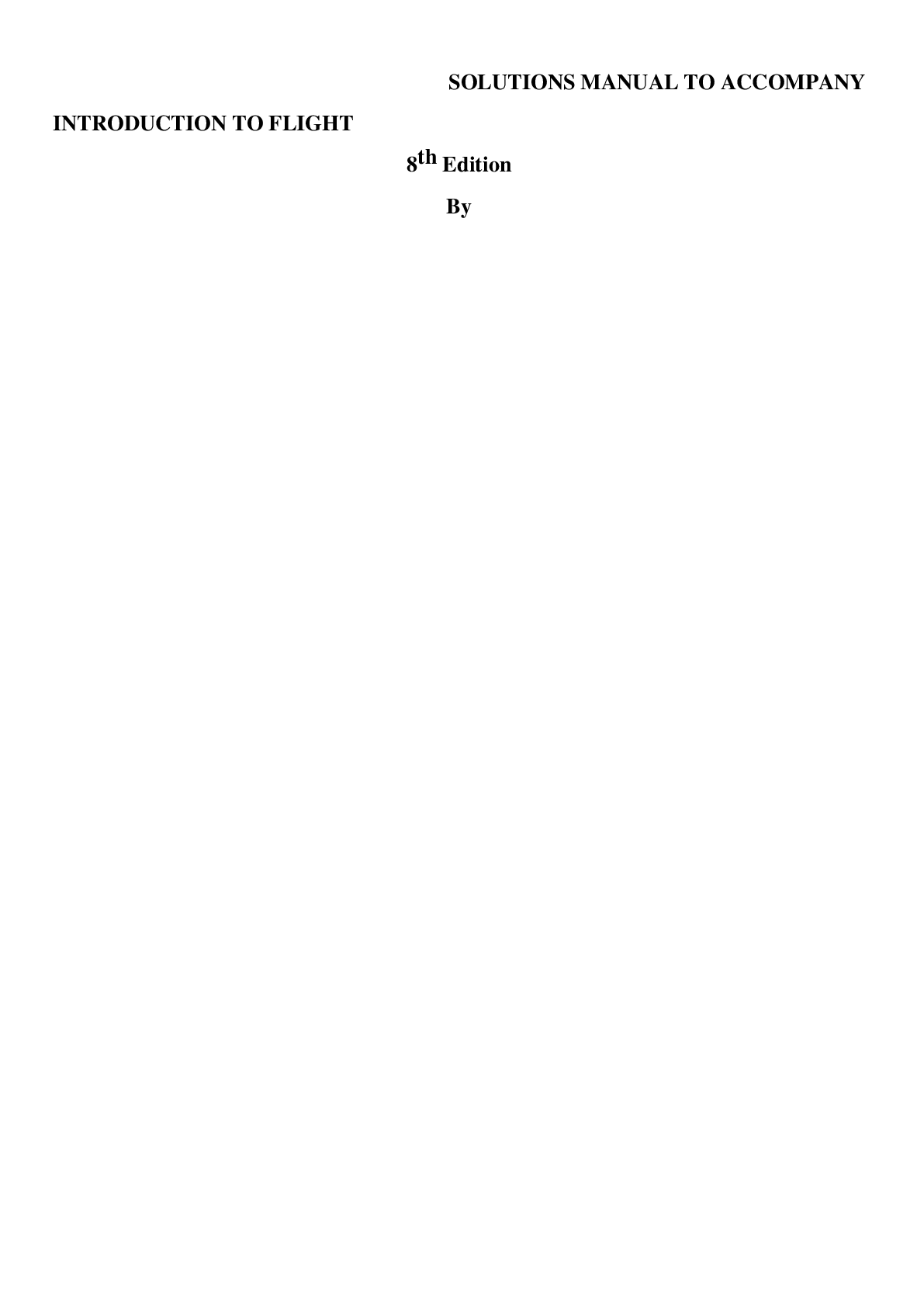
.png)
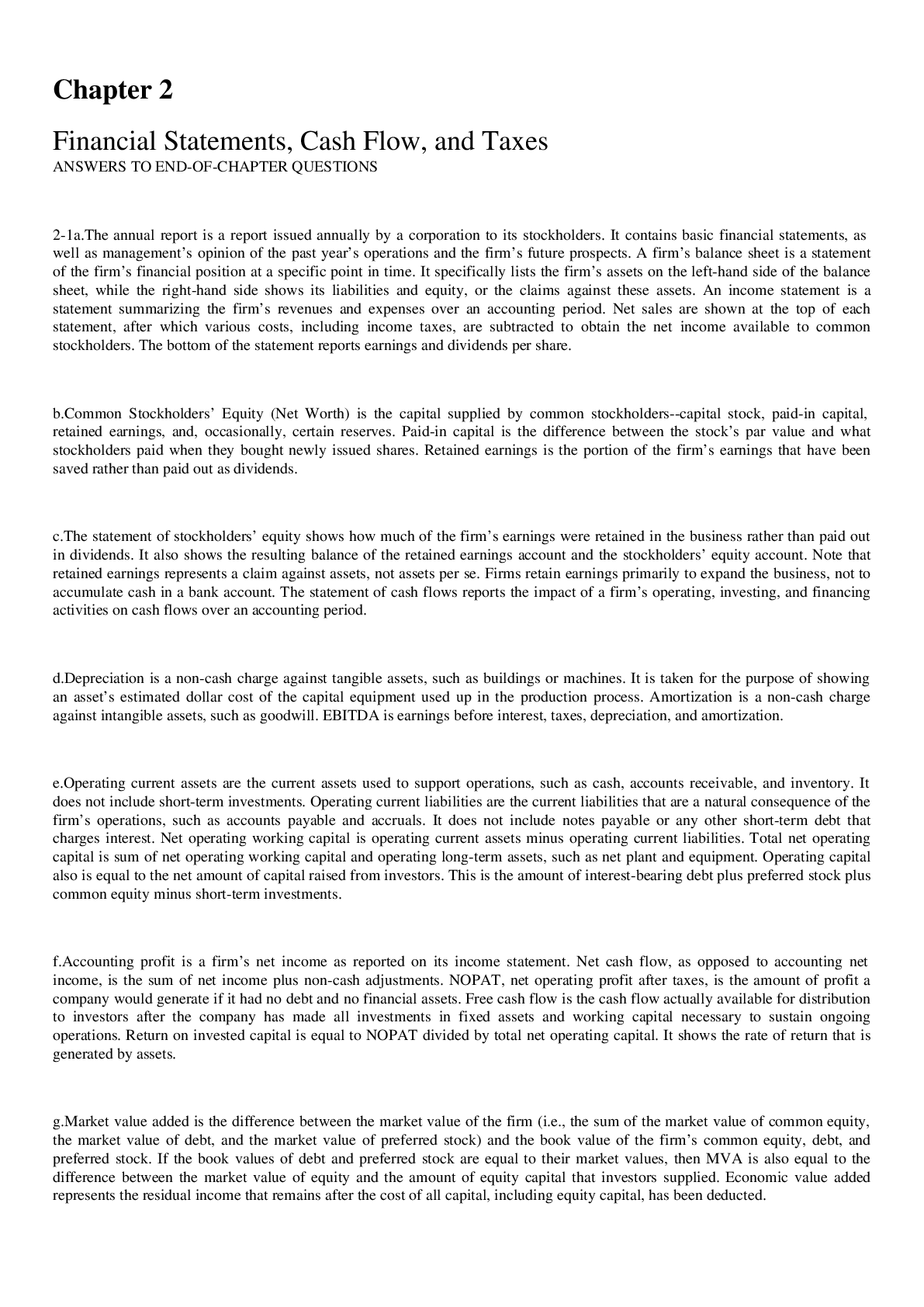
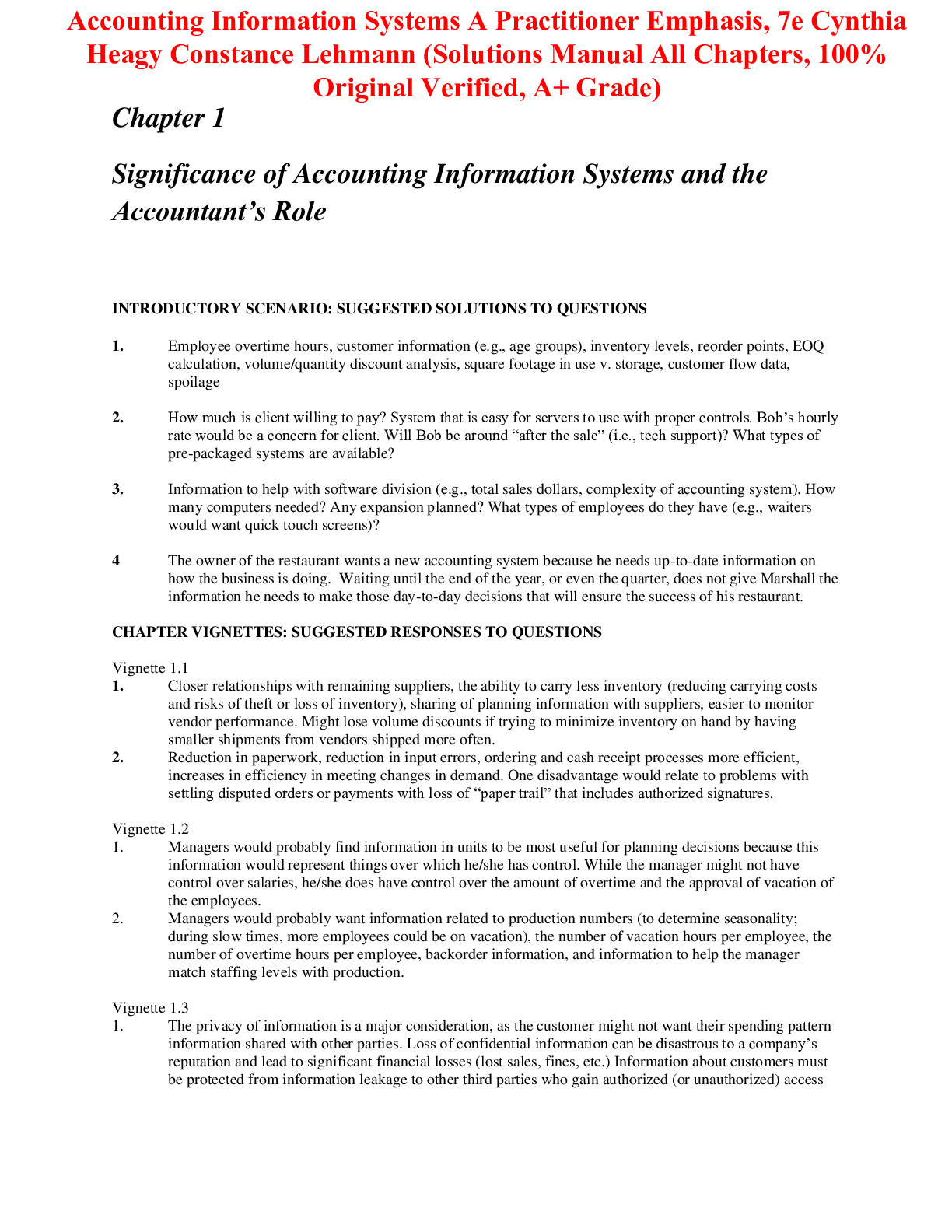
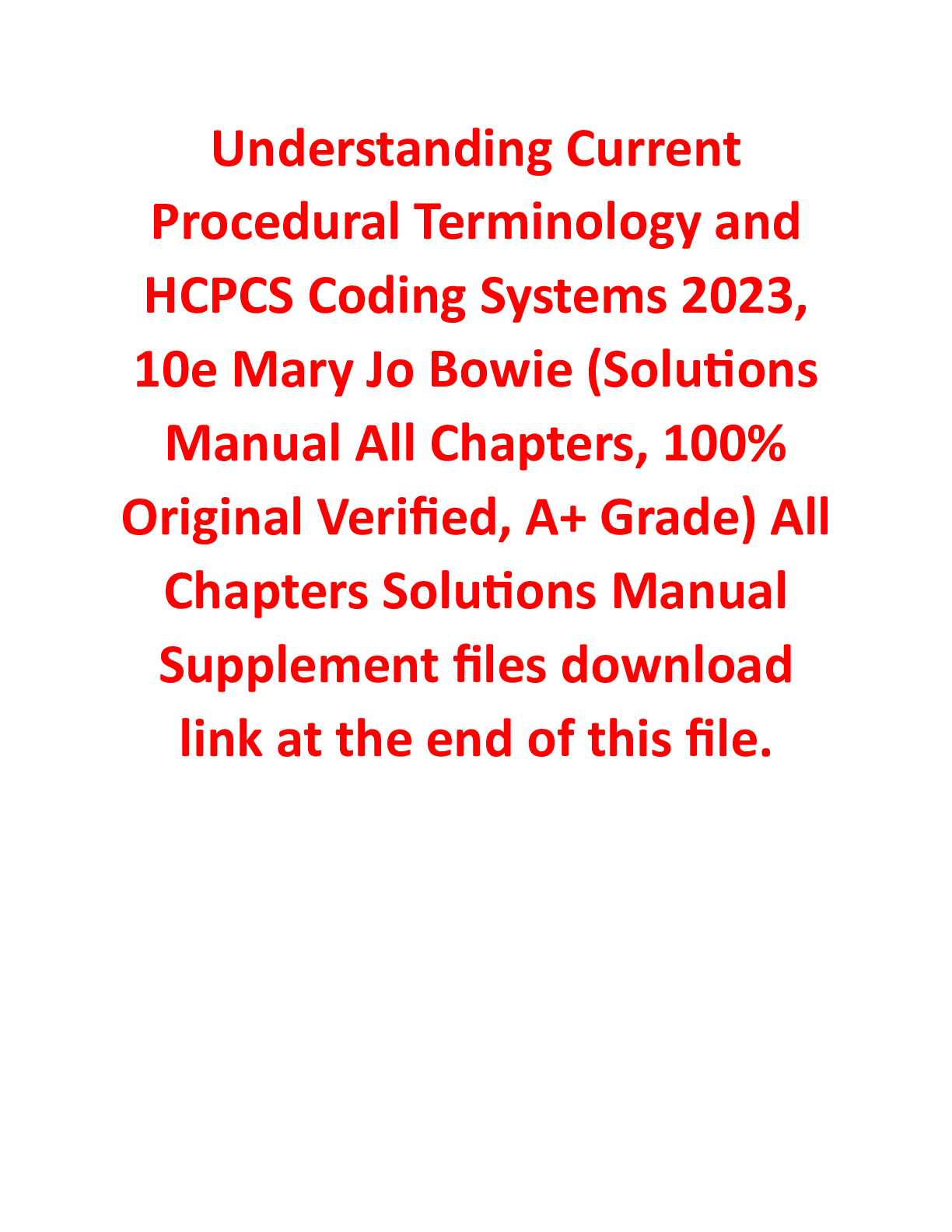

 Ken Leo, Jeffrey Knapp, Susan McGowan, John Sweeting (Solutions Manual).png)
 Rankin Stanton, McGowan Ferlauto, Tilling (Solutions Manual).png)
.png)

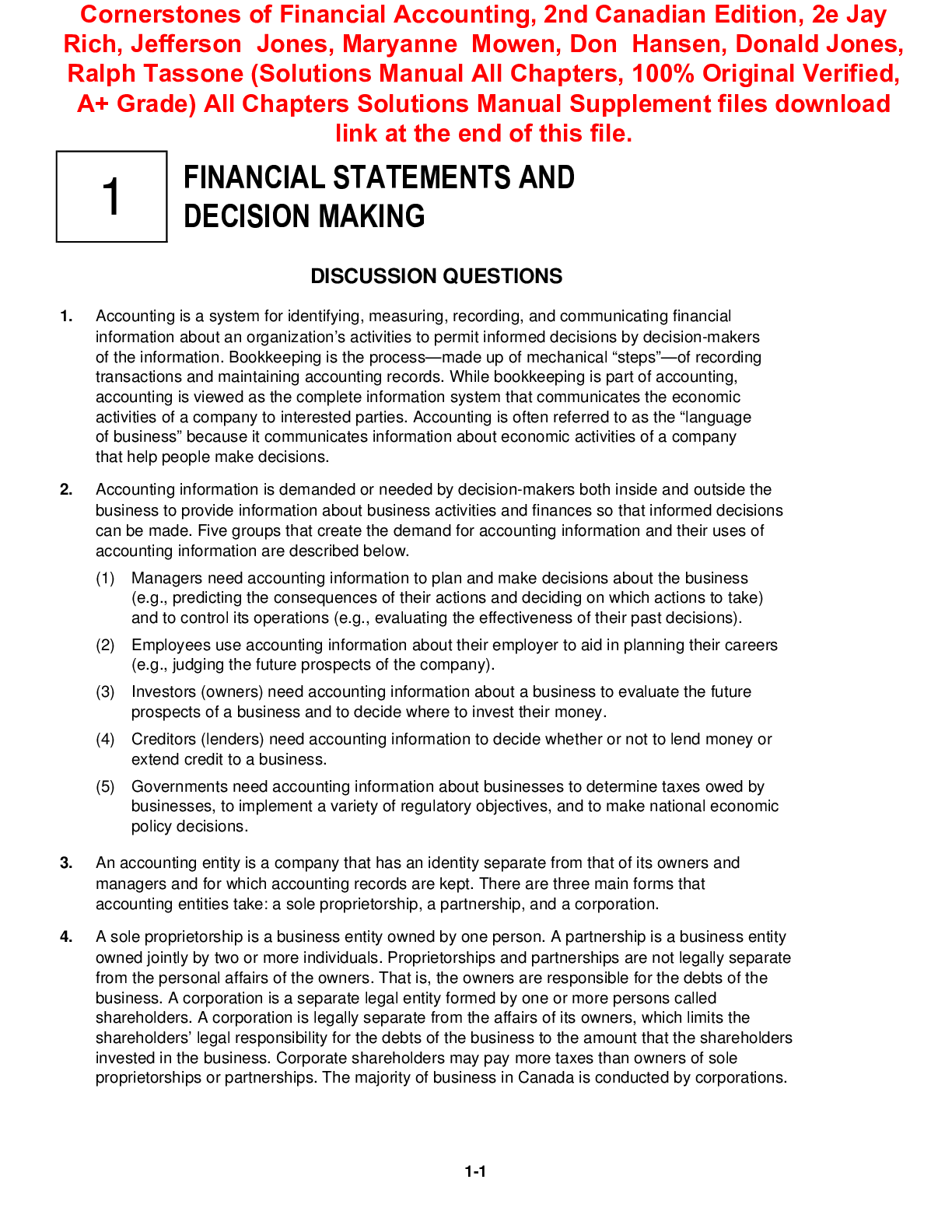

.png)


